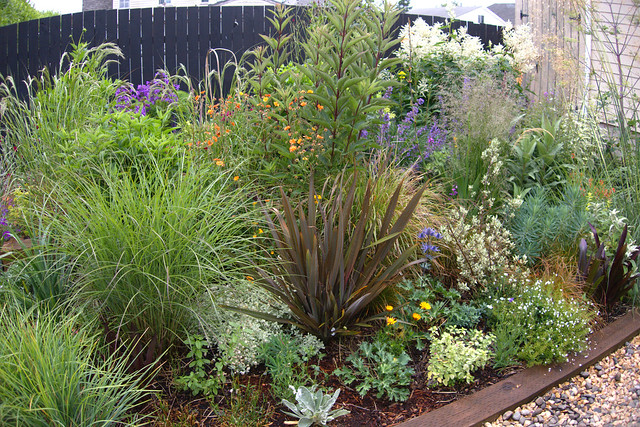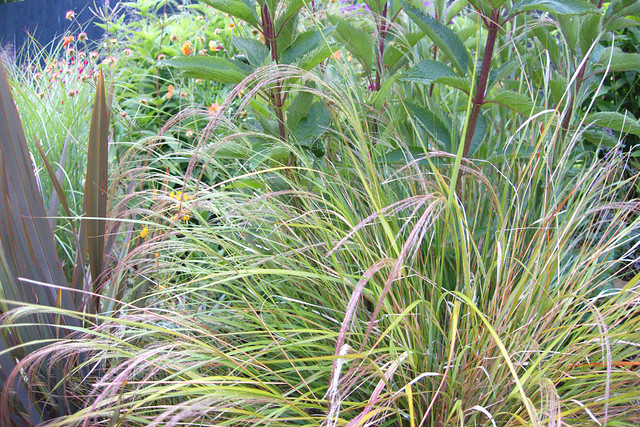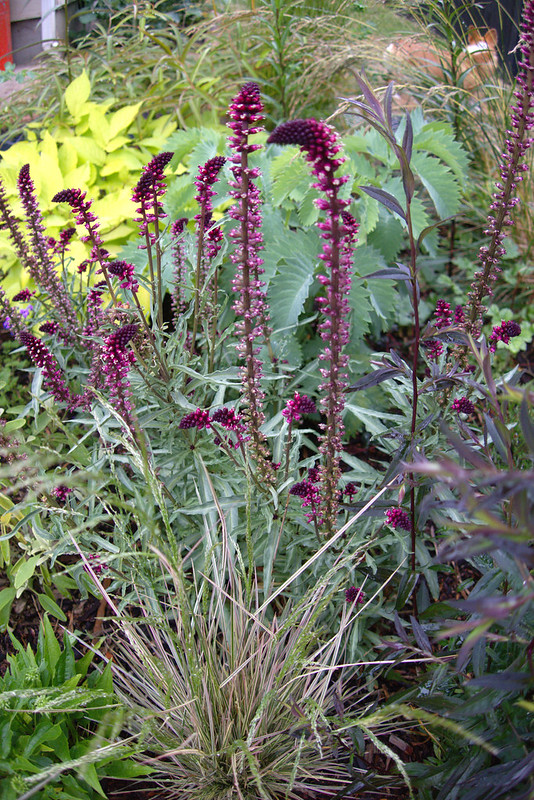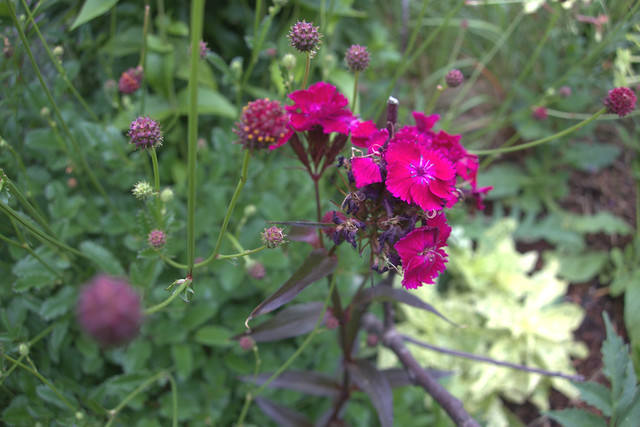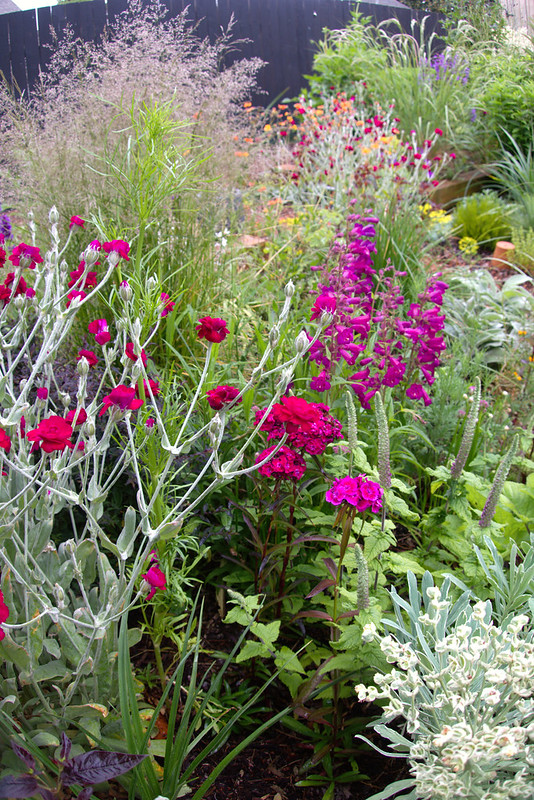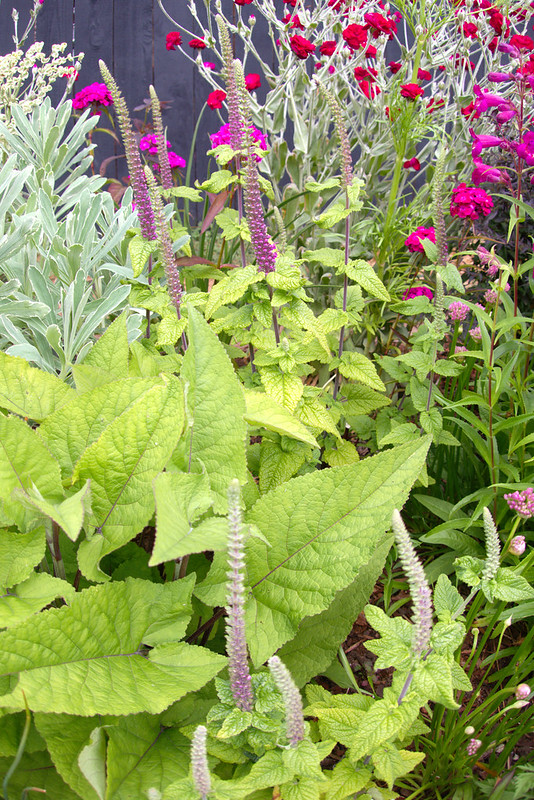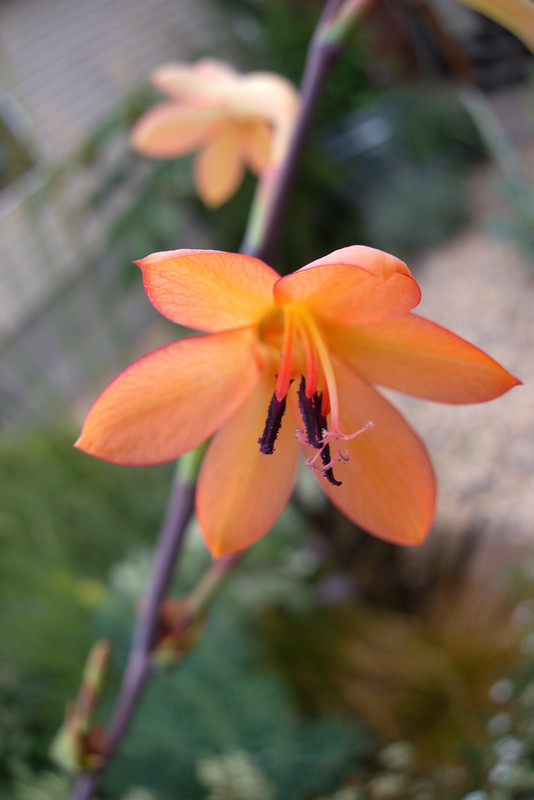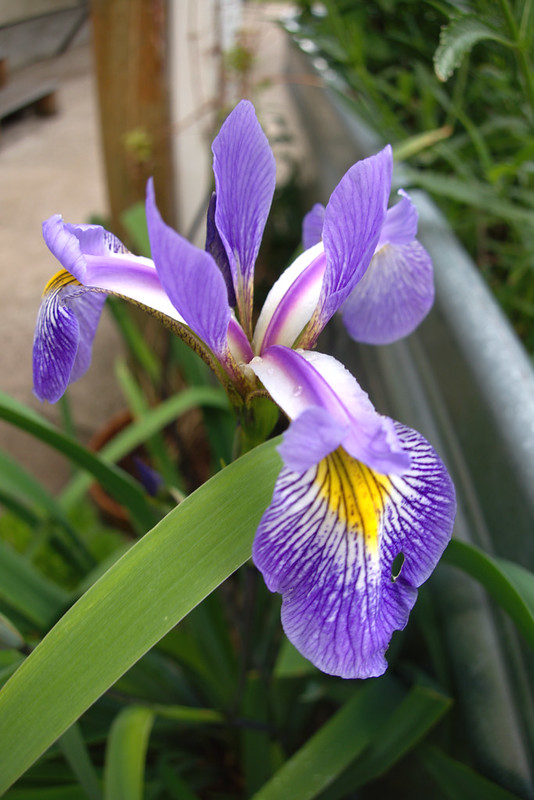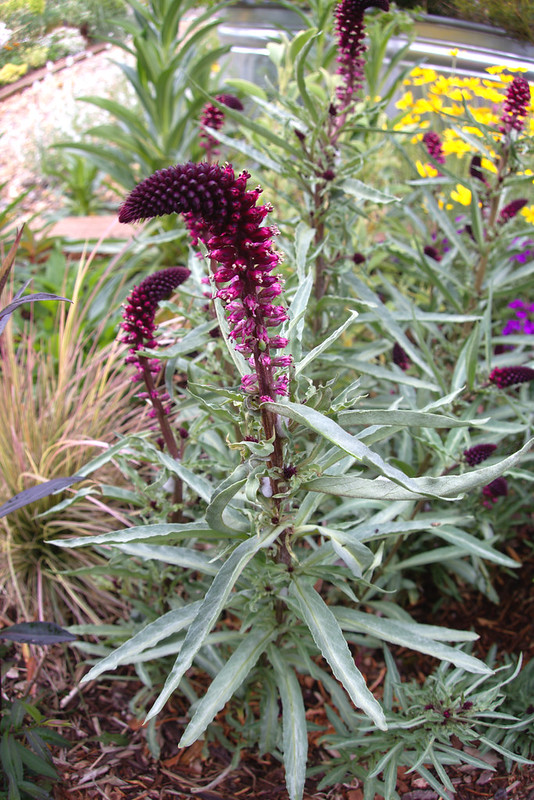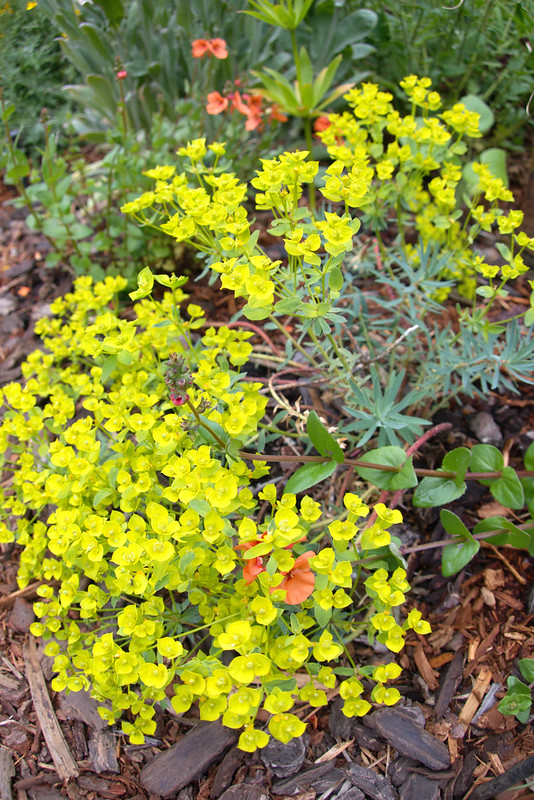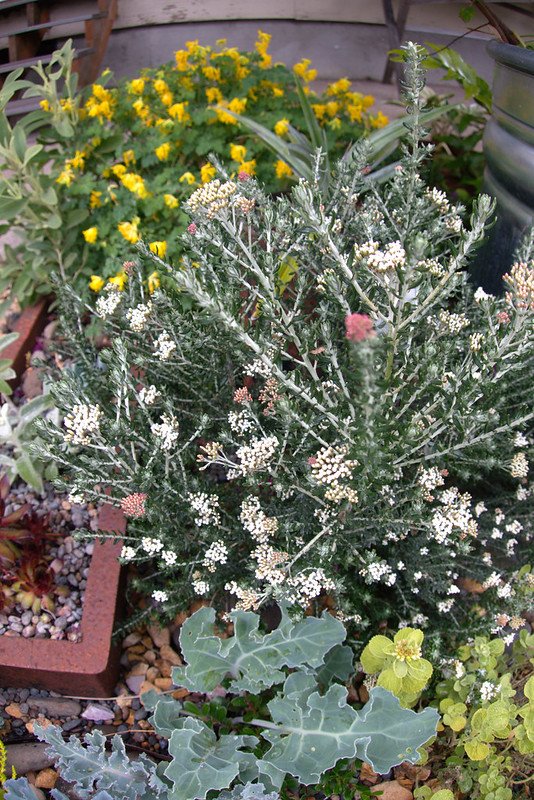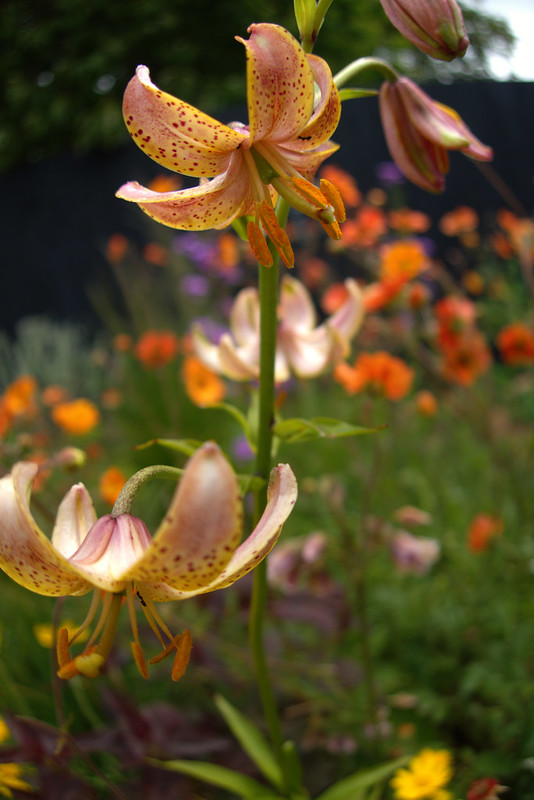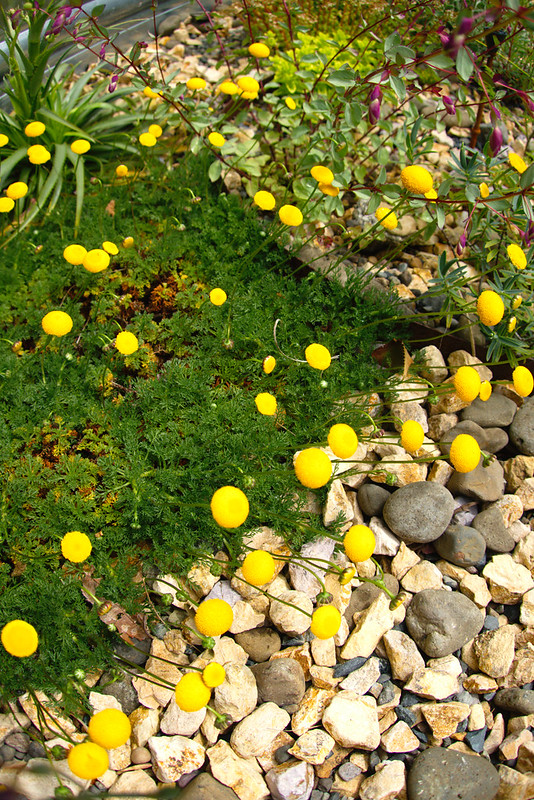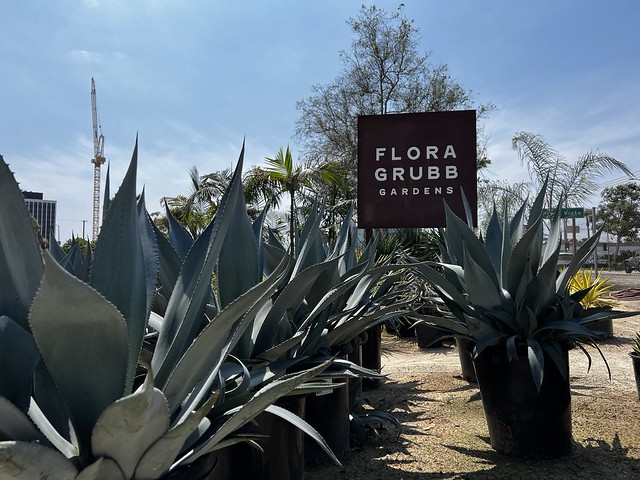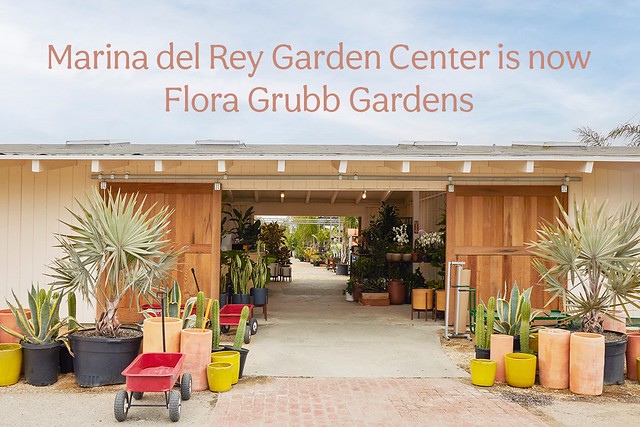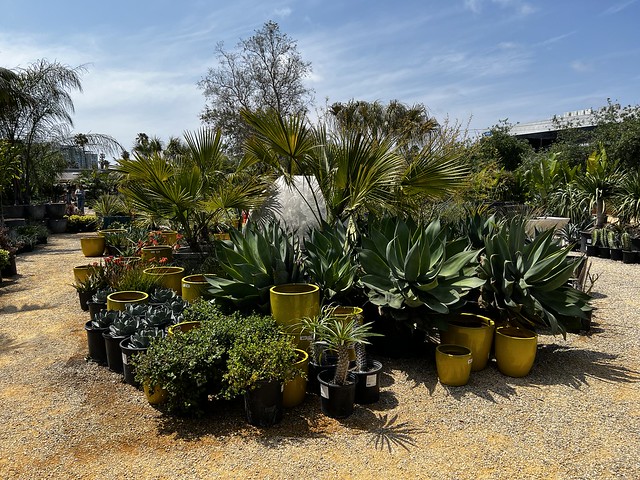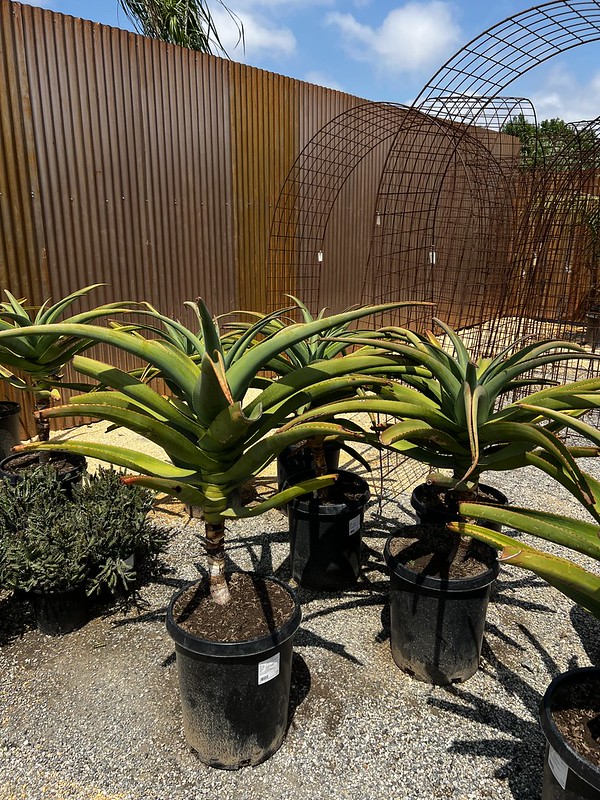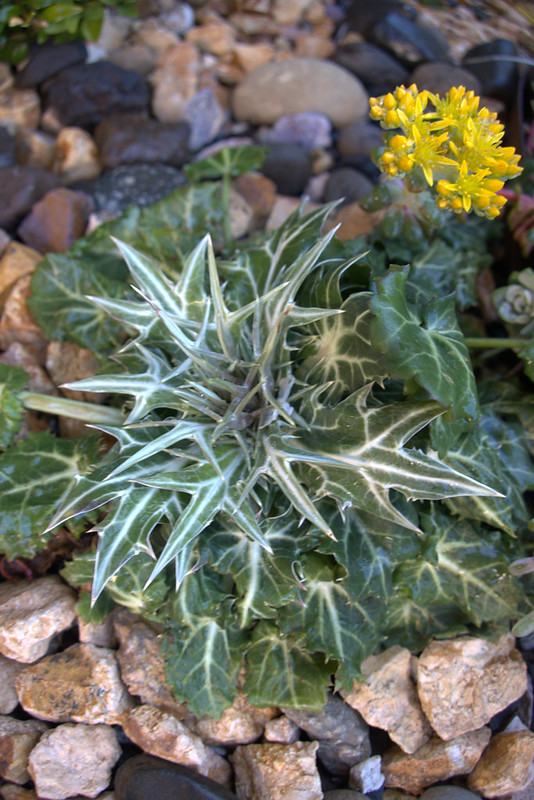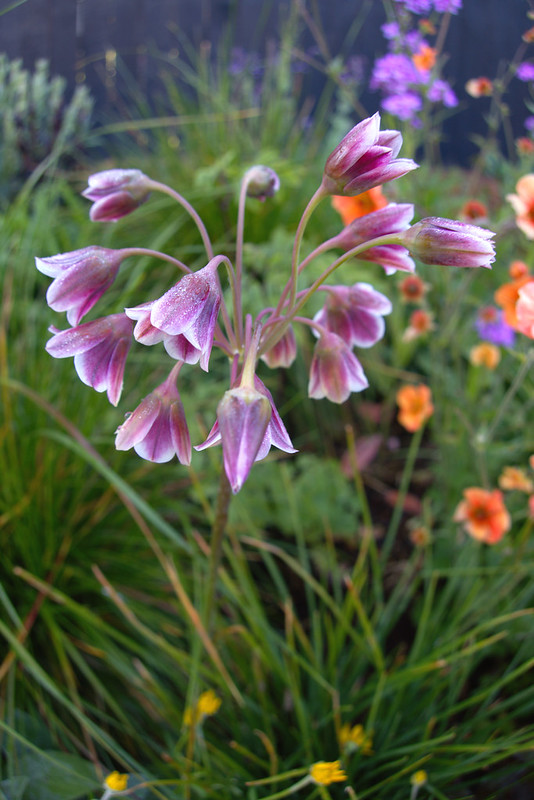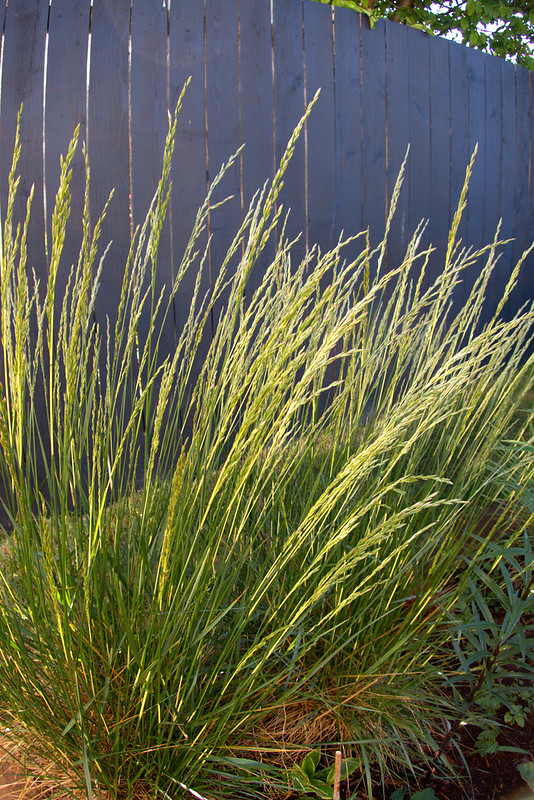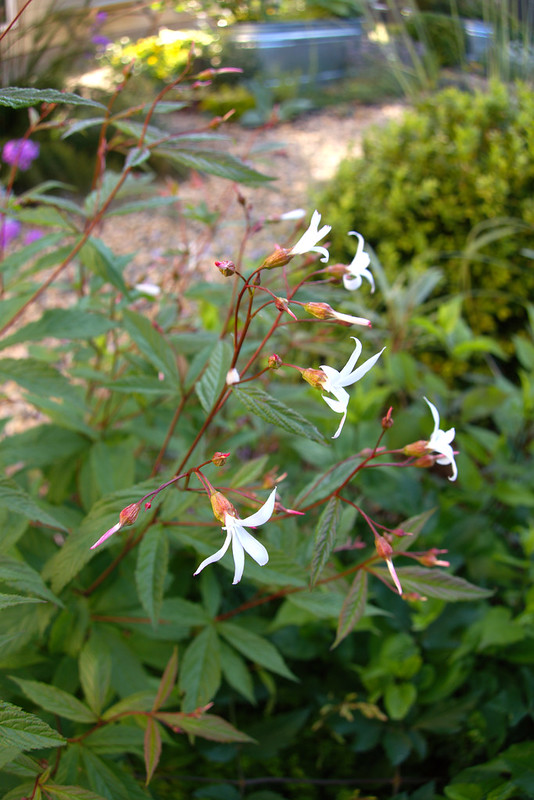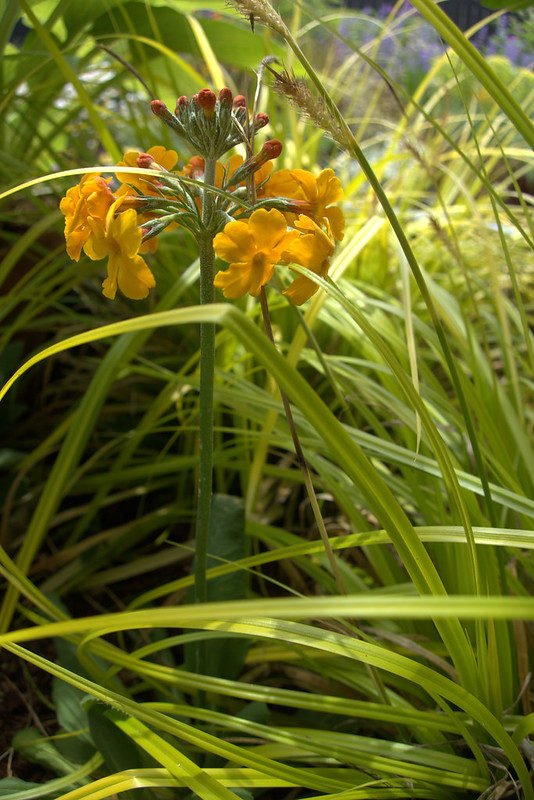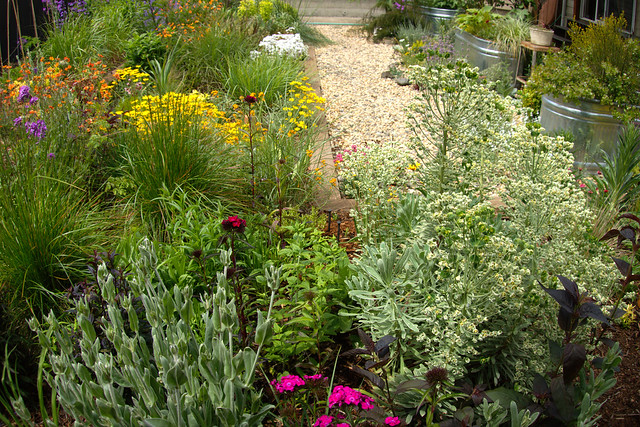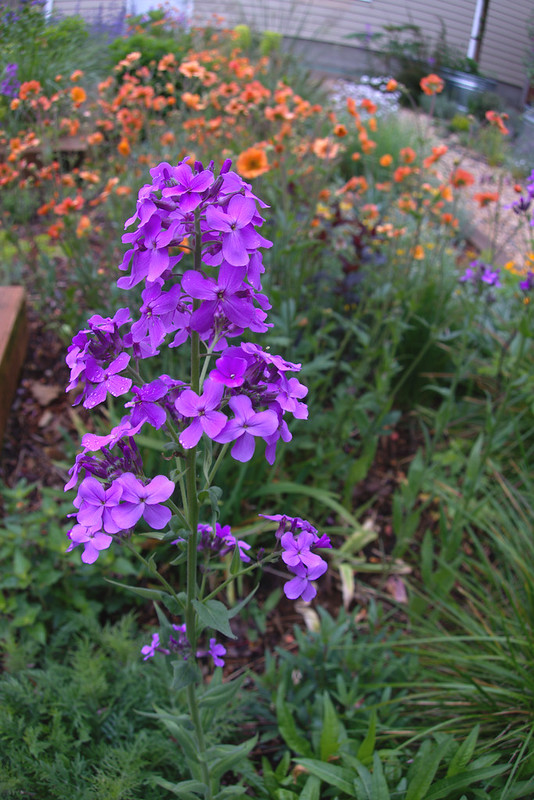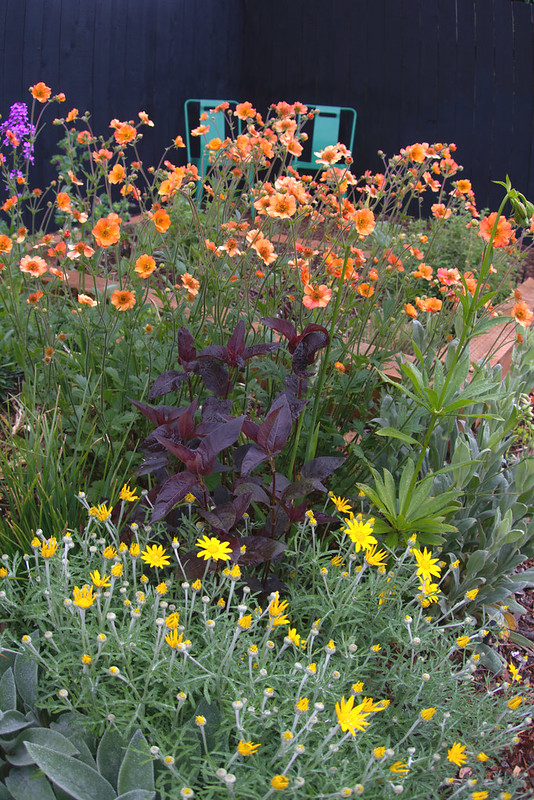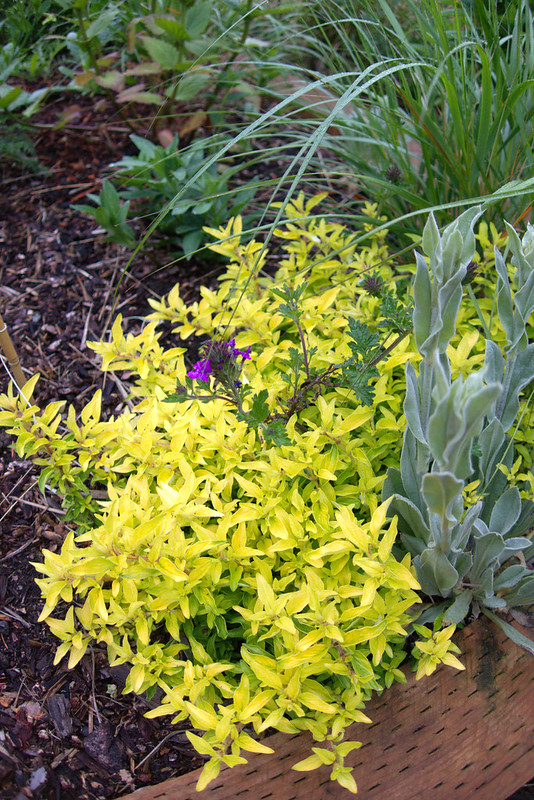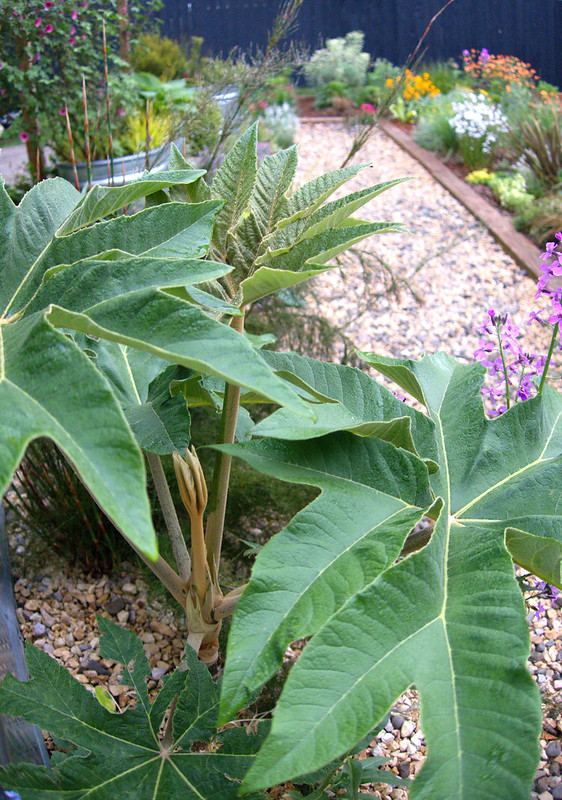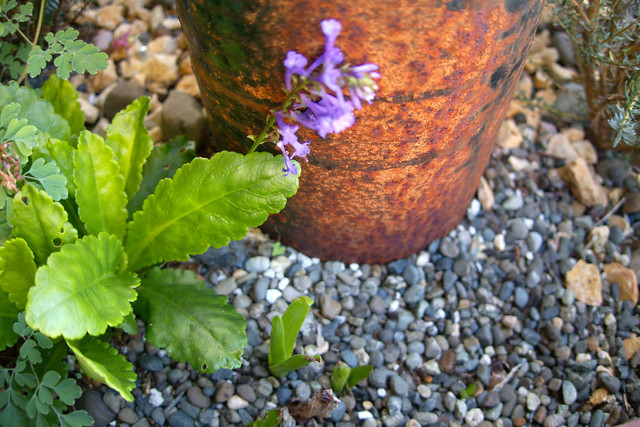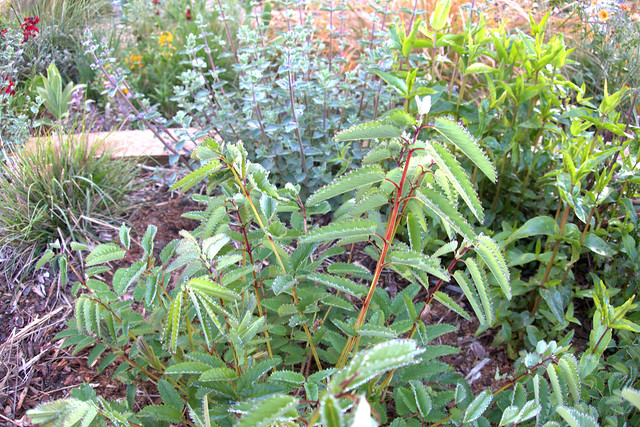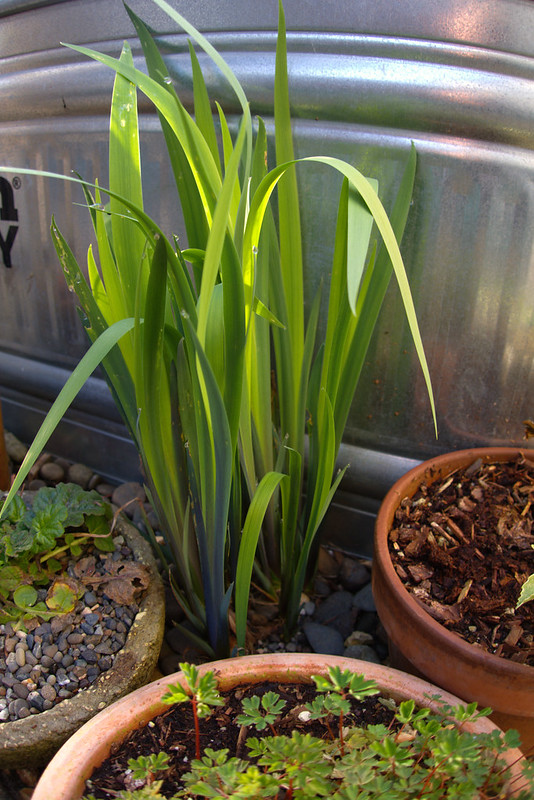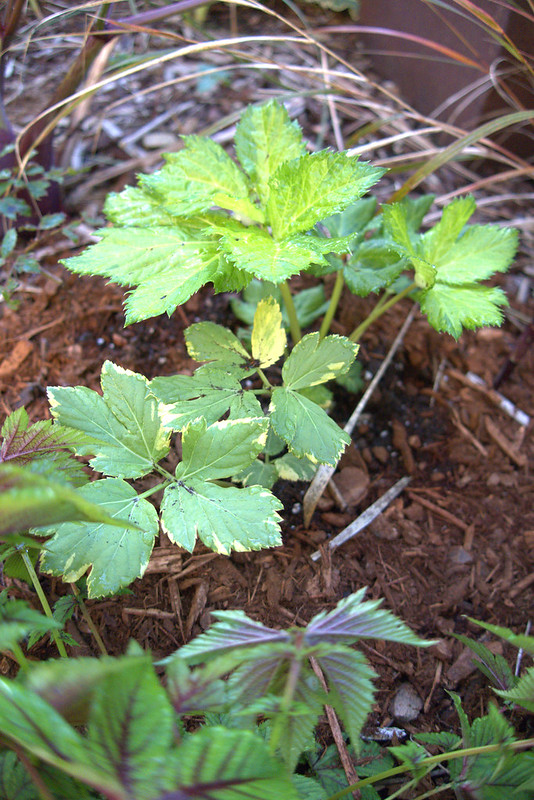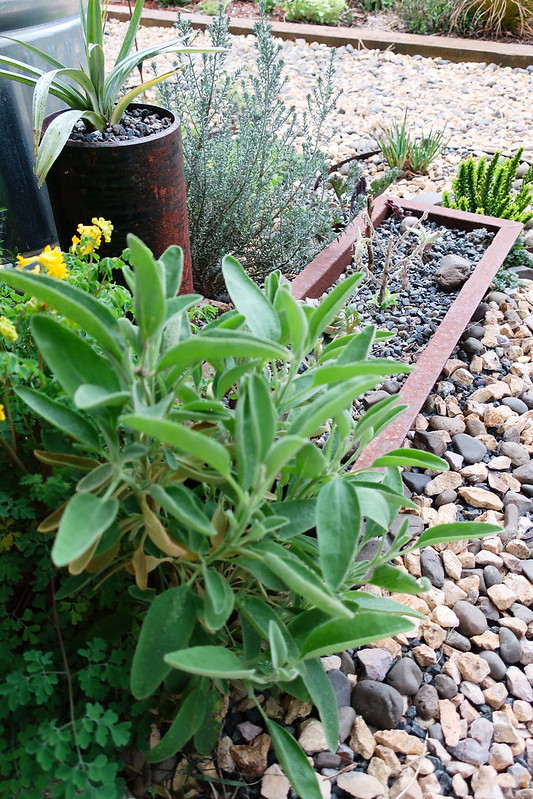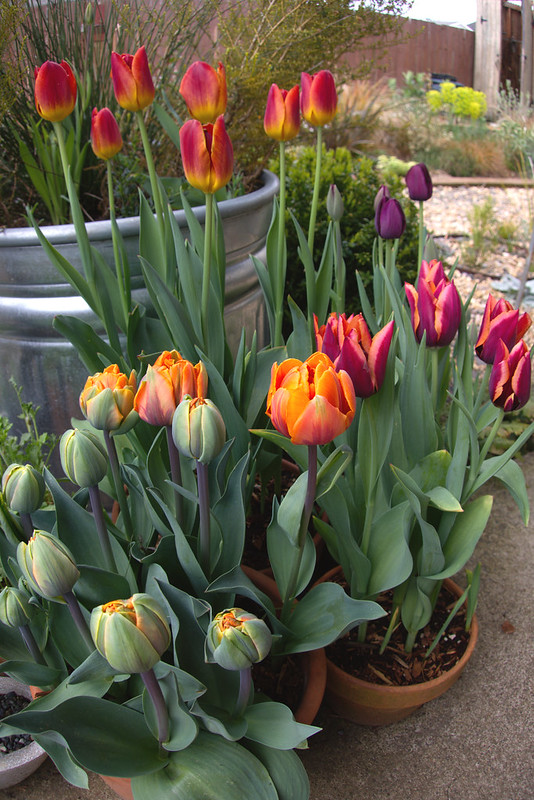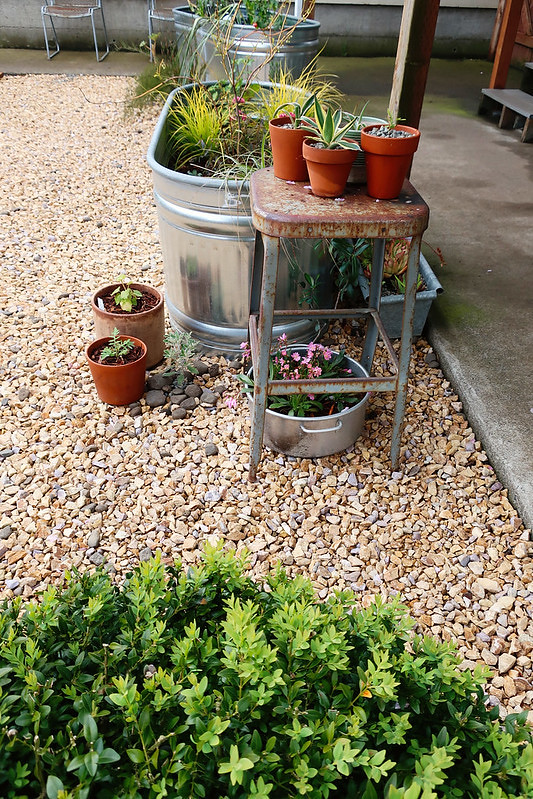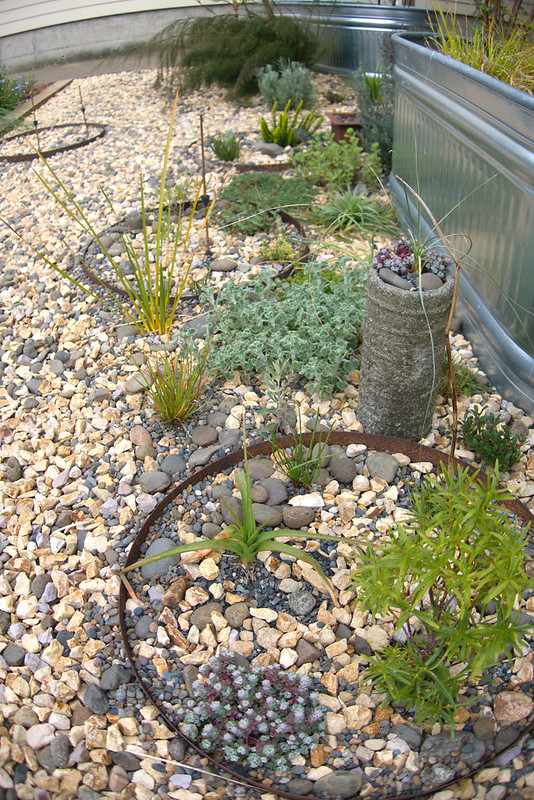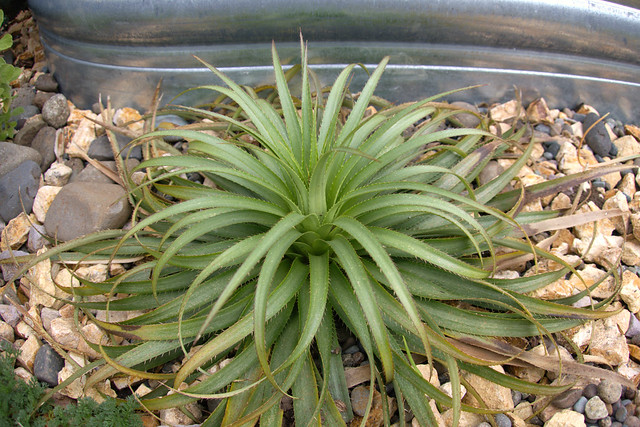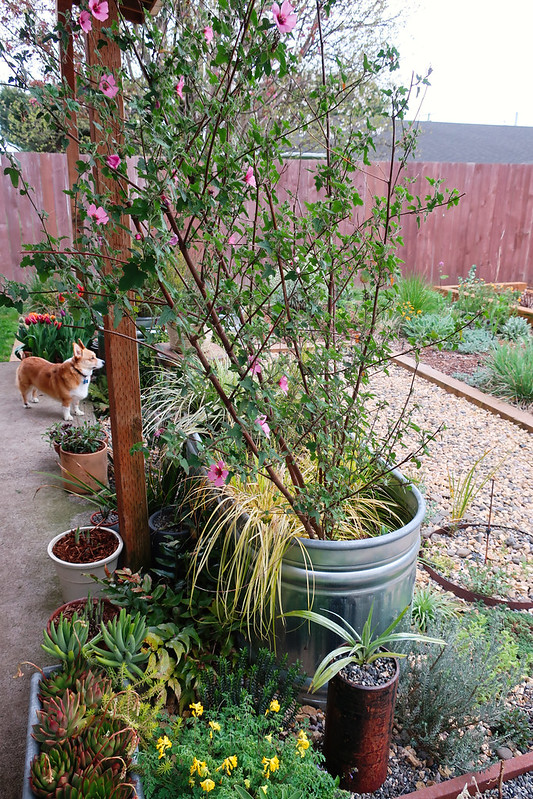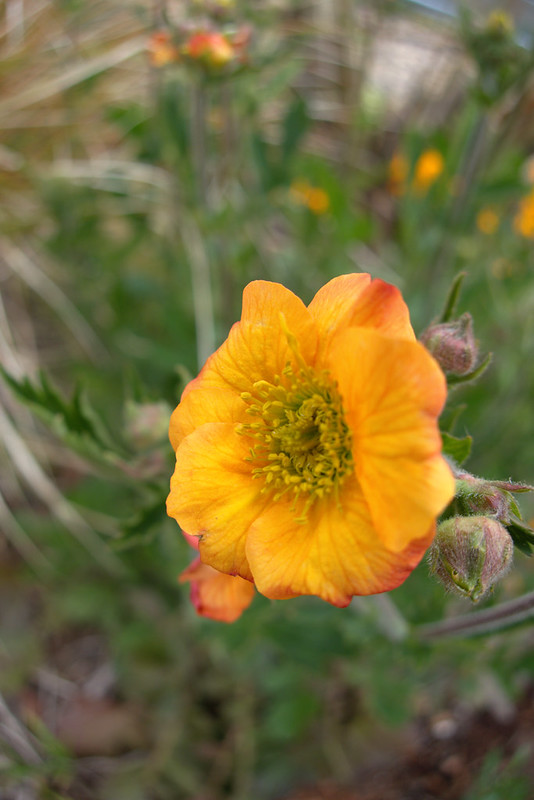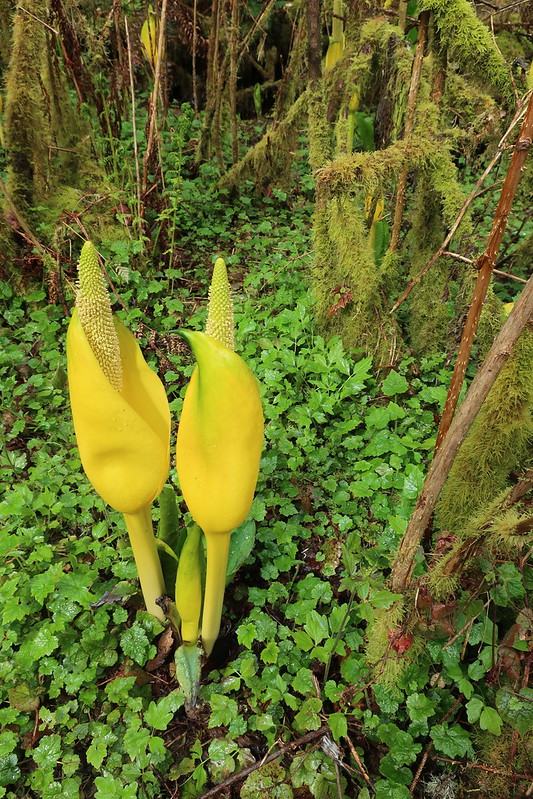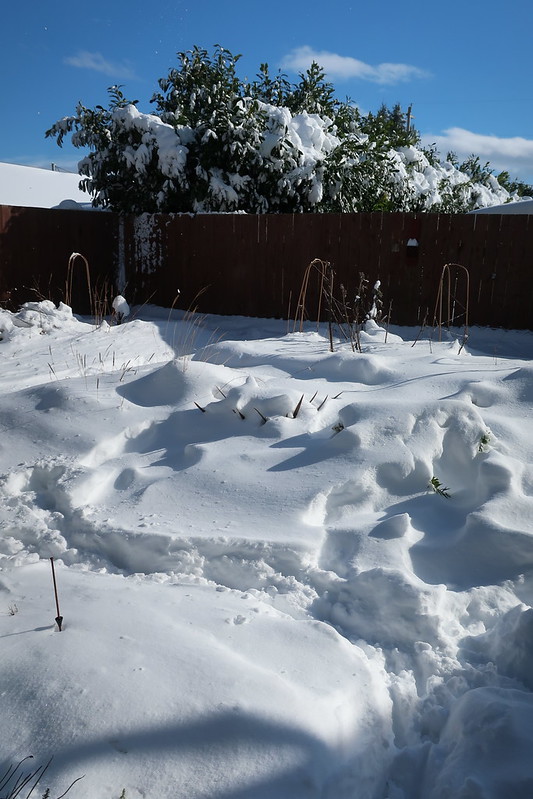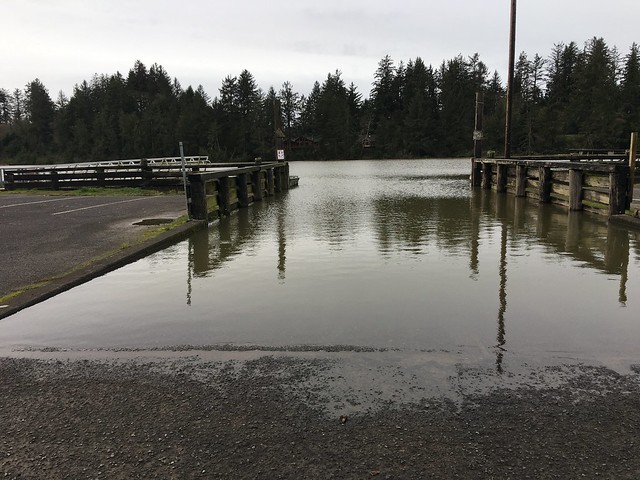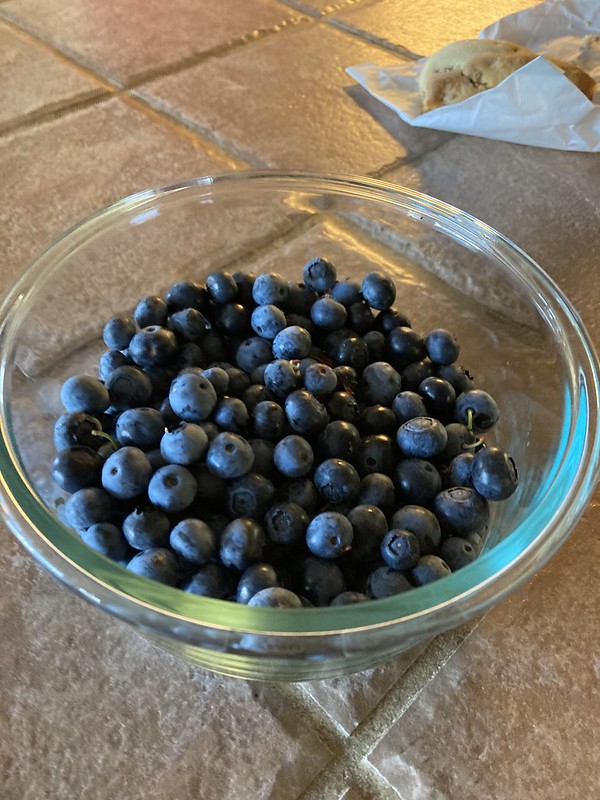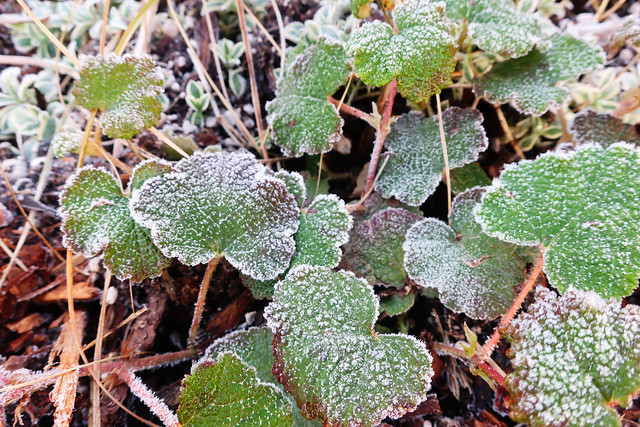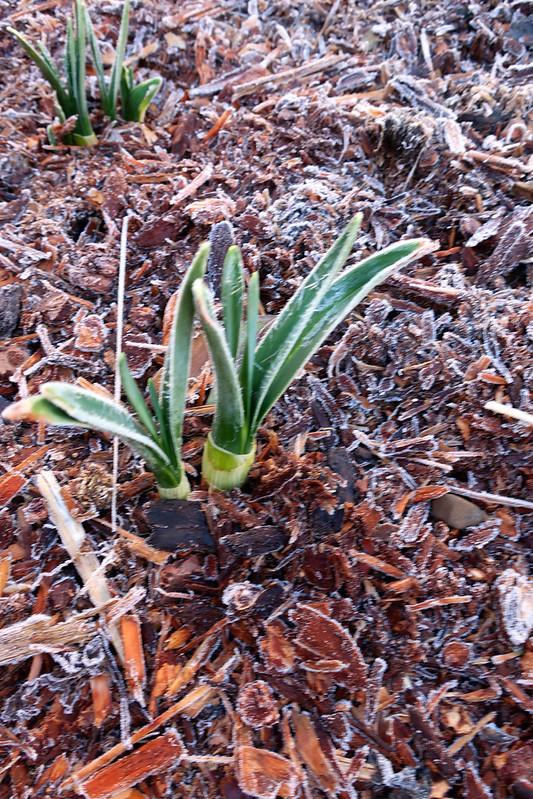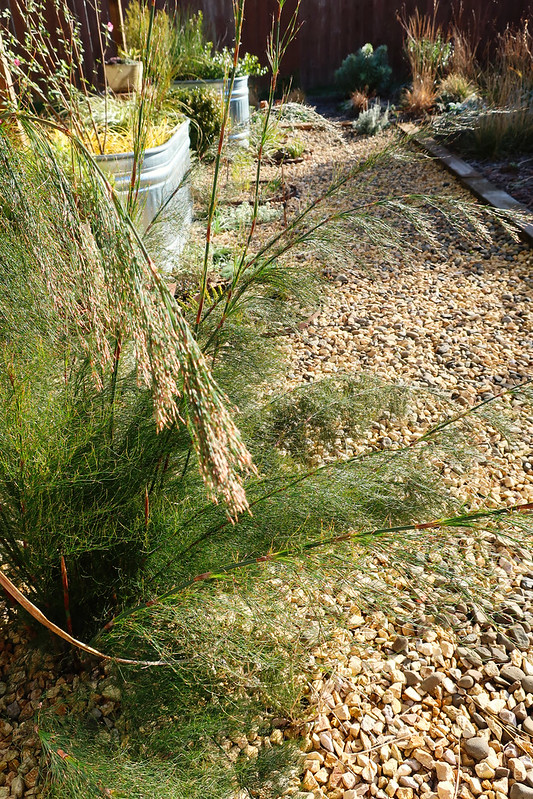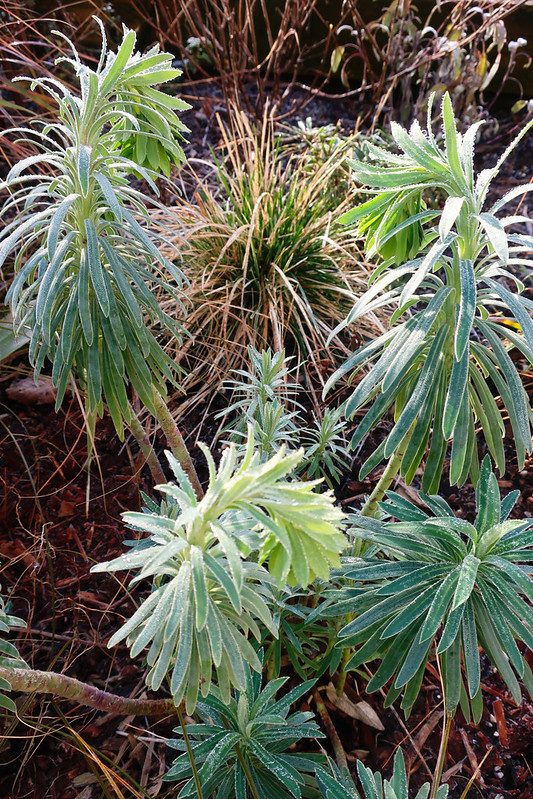On drives through the coast range I note the prominence of naturalized foxgloves in bloom is being replaced by fireweed (epilobium), the color and shape so similar that I didn’t notice the change at first. Around town rhododendrons are done, hydrangeas, dahlias and Shasta daisies are up. In my garden, July brings the penstemons and agastache into bloom, the first dahlias, Digitalis parviflora (but not D. ferruginea yet), the cool season grasses, sanguisorba, the double-flowered sterile form of Lychnis coronaria in screaming magenta, gaura, Watsonia pillansi, Lobelia tupa, patrinia, Rudbeckia triloba. Oregon Sunshine, Eriophyllum lanatum, has been cut back just as the echinacea are budding iup. Geum is having a second flush of bloom. Needless to say, July shows how I like plants in concentrated doses, where juxtapositions of leaves, shapes, and colors fire off each other.
July surges
Bloom Day June 2023
Not to be duplicative of recent posts, but just a few things that caught my eye this morning. I actually lost track of the Bloom Day timeline (15th of the month) but was out with the camera this morning to document a few things — nothing splashy, just documenting what’s up and growing and flowering — like the fabulous shrub-like quality of Persicaria polymorpha. (Side note: nearby Dahlia ‘Rosebud’ is nearly as high as the persicaria and in bud, so that will be representing for July. All four dahlias were left in the ground over winter and all returned. A local grower, Old House Dahlias, said that’s how he’d handle them here in a home garden. His operation is offline this spring/summer, don’t know why. Mine all came from OHD. I did cover them with branches from the Christmas tree, if that explains anything! But locally, in front gardens, it’s apparent that the dahlias are all treated as perennials and left in ground. Rainy zone 8b.)
Second year in the garden and first bloom for Iris x robusta ‘Gerald Darby,’ a naturally occurring hybrid of two native species, Iris versicolor x Iris virginica. It is especially celebrated for its plummy-colored new growth and season-long good looks. Not for dry soils, it can even be grown in standing water but does fine in retentive garden soils like mine.
We had light rain for a few minutes yesterday morning, the first since…the beginning of May? Daytime temps mostly in the 60s, nights in the 40s. Hope you’re having a fine June! May Dreams Gardens collects bloom day reports the 15th of each month.
Flora Grubb Takes on LA
Memorial Day Weekend was the official launch of Flora Grubb Gardens’ new location in Los Angeles. When I heard Mitch was going to take advantage of the opening 20% sale, I pleaded for a few photos. With the recent closing of the beloved Atwater Village shop Potted, the opening of another design-forward, cool-plant nursery in LA comes not a minute too soon.
FGG’s history is briefly this: With financial partner Saul Nadler, Flora Grubb opened her first shop in the Mission district of San Francisco in 2003, a neighborhood that was at that time still one of the most affordable neighborhoods in SF (before the Google bus regularly made stops there and rents became unaffordable to teachers, nurses, chefs, etc.) A series of very smart business moves quickly followed. A wholesale growing operation was acquired in San Diego in 2005, a frost-free climate ideal for growing agaves and aloes and the other beautiful dry garden plants FGG loves to showcase in their nursery and designs. In 2007 FGG moved from the Mission to Jerrold Street in the Dogpatch neighborhood, which is where I first became acquainted with FGG. At that time, Dogpatch had an industrial, tumble-down vibe and was just starting to become filled with interesting, brave, pioneer businesses like FGG. But cool things have a way of following in Flora Grubb’s wake — Dogpatch was recently named the 36th coolest neighborhood on Earth by TimeOut.
The LA branch of FGG is located on the site of the former Marina del Rey Garden Center, a nursery I routinely visited whenever court reporting work took me out that way to the conference rooms in the office towers with distracting views overlooking the glittering marina. The 90 freeway that takes you to this very upscale coastal town pretty much ends at the nursery.
From Marina del Rey Garden Center’s Facebook post of 4/23/23: We’re so happy to announce that Marina del Rey Garden Center is now Flora Grubb Gardens! We are open daily 9am-6pm at 13198 Mindanao Way in Marina del Rey. Come visit us! We can’t wait to see you.
Marina Del Rey Garden Center has served the community since 1977. In recent years, as they became more focused on sustainable gardening, they turned to Flora Grubb’s farm, Grubb & Nadler, for rare and exceptional drought tolerant plants.
When Flora Grubb heard they were ready to pass the nursery along to a new owner, she was thrilled! In 2022, the Flora Grubb Gardens team began operating Marina del Rey Garden Center and updating the site.
At Flora Grubb Gardens we believe that gardening makes people happy, brings peace into their lives, and offers a powerful antidote to the stresses of life. We believe in creating lavishly beautiful gardens that require minimal water and chemicals to maintain.
Welcome to LA, Flora Grubb Gardens!
June takes over
June is happening. Whatever garden plans you made, whatever winter took away, June is here, right now, and blots out everything else. The job now, as I see it, is admiring the incredible architecture of plants in all their phases, leaf, stem, bud and flower.
late May 2023
Fresh clumps of healthy new leaves covering the ground, strong clear colors — I really like the direction the 2-year-old garden is taking in May.
Have a relaxing long weekend (Memorial Day in the U.S.) and see you in June!
covering the ground in early spring zone 8b
Dead or alive? Since April I’ve circled the garden carefully every morning, spine at a right angle to the ground, and posed that question to the plants…or the empty space I remember growing plants. Looking for signs of life in Salvia uliginosa (no-show as yet/dead); Salvia nutans (growth from one clump out of two); Aloe cooperi (strong growth from one plant, new nubbins from a second plant.). I inspect the garden daily both for signs of survival and also for what makes an early presence in spring.
There’s visible growth on veronicastrum, on eupatorium. But one of my favorite plants from last year, the dog fennel Eupatorium capillifolium ‘Elegant Feather,’ is so far a no-show. Too early or dead? Canna ‘Cleopatra’ is showing growth. I had no idea if planting this last fall was sane. I left the dahlias in the ground more out of neglect than planning, and surprisingly two are showing growth. All the Sideritis oroteneriffae in the ground perished, but one planted in a bottomless container slightly under the eaves is producing new growth at the base.
At least this year there is some growth to inspect. Last year, the first spring in this Oregon garden, was an agonizing time without much to look at in May. Since then I’ve focused on early growth from mostly herbaceous, sun-loving plants after a cold, wet (rain forest wet!) zone 8b winter. I’ve sown biennials like sweet william and hesperis for their early presence. It’s a vast subject, to get a wet 8b garden in sun up on its legs in early spring, so if you have any suggestions I’m all ears! I’ve been adding bulbs but avoiding peonies and early flowering shrubs for now.
The wallflowers, erysimum, thrive here and ignite the May garden. The large-leaved lamb’s ears is scruffy all winter but rights itself early for some gorgeous clumps. Foreground left is a miscanthus, late to bulk up, but behind the wallflower is a treasure, an Oregon native, cool season grass Deschampsia cespitosa in the very good form ‘Goldtau.’ I’m also growing quite a few clumps of the older variegated variety ‘Northern Lights’ which is easier to find.
what’s up (April 2023)
Waiting, longing, wracked with anticipation for the garden to jump into growth is an entirely new experience for me, born and raised in the eternal sunshine of zone 10. When the slow emergence of spring in zone 8b begins — lord have mercy it’s exciting! It feels like there needs to be some sort of authoritative summation on the state of the garden, on life, on the disgraceful behavior of our species…but that feels too much like homework. So instead, here’s a brief roundup of what the camera found today, at the ass end of April, on the Oregon coast, after what I’m told was an exceptionally rough winter. (There was snow! A blanket of it swaddled the garden for a week!)
What looks good when the garden is just starting to stir in April? In my garden, in one word, phlomis. Unscathed, fully clothed, holding it together all winter. I didn’t expect phlomis could deal with this much rain, hail and snow, but see for yourself.
And for mainlining the life force, jumpstarting slumbering rods and cones, another easy answer: tulips in pots. In colors you’ll never find locally available. (You must rouse yourself in July and order then for the best selection.) They’re the perfect aperitif for opening the growing season, especially for me because I don’t plan for much strong color for summer.
Thalictrum — I’ve daydreamed about growing thalictrum for many years, in a good, moisture-retentive soil. Early emergence of delicate ferny leaves followed by a massive rush of growth to head height. ‘Elin’ was planted last year, two ‘Black Stockings’ were added in March. Yellow-flowered Thalictrum lucidum will arrive in May.
The euphorbias bring a strong early presence.
And always shopping for more. I bumped into this bigeneric cross of bergenia and mukdenia last week with the sempervivum-like flowers and couldn’t think of a reason not to buy it. There is no reason, right?
Light snow again mid April. Yesterday spiked into the high 80s, at least 20 degrees over the norm, but we’ve climbed back down into the 60sF with the possibility of rain tomorrow…and some more in May but then drier days ahead…
swamp lanterns at Rockaway Cedar Preserve Hike
In 2019 a mile-long raised boardwalk was built over a small remnant of old-growth coastal bog right off of Highway 101 about 20 minutes north of us. Typical of many beautiful places in Oregon, signage is not conspicuous, and if you didn’t know it was there you’d never find the Rockaway Cedar Preserve Hike.
Had I known it was there last year, I could have experienced the luminous skunk cabbage spring bloom leisurely, up close and on foot, instead of craning to see the blooms whizzing by through the car window while passing by boggy roadsides with no turnout.
Western skunk cabbage aka swamp lanterns aka Lysichiton americanus, whose roots were roasted by native people, the enormous leaves used as baskets and food wraps, along with every part including sap utilized for all manner of medicinal uses. It is a big, strappy, charismatic, lusty aroid, a swamp dweller, beetle-pollinated, stridently blaring the imminence of longer, drier days ahead to the disbelieving. A fluorescent yellow exclamation mark to herald the end of winter. Huzzah!
It’s just the fecund, primordial experience needed while spring slowly stirs itself and sleepily gets up on its elbows…
Billie in the snow
February was not just about prettily frosted plants. Later in the month the garden was buried in almost a foot of snow. Unheard of amounts of snow, I’m told! Schools and city hall closed for a couple days, and the snow stayed on the ground about a week.
For most of February the Oregon garden continued to be pummeled by frosts and feet of snow. This amount of snow, I’m told, is unusual. The garden and gardener may be on winter hiatus, but the energy normally poured into plants and garden inevitably spills over onto the wider surroundings, which to me are a novel and fascinating ecosystem.
I haven’t said much here, but after growing up in Los Angeles, living among small towns in a temperate rain forest is an extraordinary change. Traveling along the coast, I compulsively check the population numbers of every town we pass through — Marty is used to this tic now. Renowned PNW writer Ken Kesey described them as “Towns dependent on what they are able to wrest from the sea in front of them and from the mountains behind, trapped between both.”
The geographic isolation works to both attract and repel. I’ve met families who’ve been here several generations that can’t conceive of living anywhere else. But word occasionally gets around that so-and-so is leaving, moving away because they can’t take the small-town isolation anymore.
Our own small town of approx 5,000 functions as a “15-minute city” (I can get anything I need on foot in 15 minutes). It will never see sprawl — not through proactive design but because there’s not much buildable land in a small town surrounded by farms, rivers and floodplains. Big enough for reliable buses, trash pickup, utilities, supercharger stations a block away. Veterinarians, dentists, hospital, groceries, seasonal farmer markets, schools, haircuts, hardware store, microbeer, boat launch, library, all within walkable distance. Most of the other coastal town populations come in under a thousand. The majority of towns appear to have a seasonal population — tourism replaces industry.
How many people does it take to keep a town functional? What industries have come and gone, and why? Forest fires ravaged the timber industry in the fairly recent past (see Tillamook Burn), and my town is down to one lumber mill. Every morning I am greeted by its plume of smoke to the east when sitting under the overhang having the first coffee in the garden with Billie. The replanted burn areas have grown in surprisingly fast, but the mills are gone for good. Lumber will no longer be the powerhouse employer it once was. A coastal railway operating from the coast to Portland was so severely damaged in winter storms that in 2007 is was decided the cost was too great to fix, and repairs would also likely damage spawning grounds, so the railway line was abandoned. Overfishing ended most commercial fishing, with sport fishing taking up the slack now. Oysters, clams and crabs still multiply lustily in this unique five-river estuary, the second largest in Oregon.
Indigenous people became “complex” hunter-gatherers here in this narrow coastal strip bounded by the Coast Range, able to build permanent houses and complex social structures without a written language. This defies the old anthropologic saw that agriculture and its surpluses are first acquired and then permanent dwellings and complex societies follow. Here the abundance of food, and especially the predictability of the salmon runs, allowed for permanent villages of cedar plank houses. Cedar also made water-proof clothing, baskets, canoes — it was put to protean uses.
The geographic isolation of the coast worked to the advantage of the native people for thousands of years, until European fur traders sailed in. Very soon after, the native people succumbed to European diseases and settler disputes, with the rapidly dwindling number of tribal members eventually pushed to reservations. Just driving along the coast brings all this readily to mind. The rivers, the ocean, the mountains, the geographic isolation even now with just a couple roads, the winter-long rain — all tell vivid stories of the limits and possibilities here.
The dairy farmers seem to be thriving despite new rules protecting wetlands, spawning grounds, and the watershed. There is grumbling but respectful cooperation. Small farms are gaining a toehold, growing seasonal produce for restaurants, farmer markets, and CSA boxes.
Unlike Los Angeles, everything is tangible, visible on the surface, the systems easy to read. Geography rules! Los Angeles is a subtle ecosystem easily overrun by ambition, at least in the short term until water supplies capsize. Here geography and climate have the final say. Cause and effects happen in real time. Housing is scarce and locals cannot afford to buy a house on local wages — some things are constant. Child care is not just scarce but impossible to find — another constant.
Just some quick thoughts on small towns where, for good or ill, the machinery that makes towns run, or not, is in full view. In LA it was always inscrutable to me, starting with that crazy concrete-bottomed river, which I hear is near to overflowing lately…
really gets me frosted (February in zone 8b)
Changeable, volatile, sunny, rainy, hail for 5 minutes, sunny again, pouring buckets an hour later — this slice of temperate rain forest is all the weather I never got in LA…in one day! I used to perceive LA’s skies as being in stasis, chronically blue and bright. Now my garden is the thing seemingly in stasis the past couple months, which brings fresh insights into so much of the classic garden literature. For example, I get the tribe of galanthophiles now — hungry for any signs of green piercing the brown plane as early in the season as possible.
I haven’t gone the snowdrop route yet, but I do compulsively count evidence of emerging bulbs. These are narcissus, but really who cares what they are? Twelve green nubbins is what they are! Allium are up too, and countable.
Something else I’ll be counting will no doubt be plant losses. Iffy plants, like this beschorneria, should ideally be planted early to have all summer to make size. Even though it is rated to 10-15F, I wish I had planted it in spring, not fall. Established plants have much better odds of making it through their first winter, just as established plants handle drought better in zone 10.
And I will grow a euphorbia, some euphorbia, in whatever garden I make, that’s nothing new. Seeing them stirring into bloom in frosty February brings a whole new level of appreciation. Like seeing new attributes in a dear friend.
And now biennials make sense too. They made no sense in LA. I mean why go through the bother of sowing them in August, growing them on for a year, etc, when there’s so many other choices? Well, I’ll tell you why. They’re hardy, for one thing, and Sweet Rocket keeps its leaves all winter and will be in bloom early in spring when a lot of the garden is just waking up. I know because I saw it in bloom in a local garden last year. Will I like the way it looks in the garden? Not sure, but I know I will appreciate the effort when it happens.
I wasn’t sure my enthusiasm for phlomis would jive with all this rain, but so far they’re looking fine. Also growing Phlomis aurea and Phlomis anatolica ‘Lloyd’s Variety’ and always on the hunt for more…No new phlomis coming in a couple plant orders pending, but we’ll see how eremurus finds life here at the Oregon coast.





